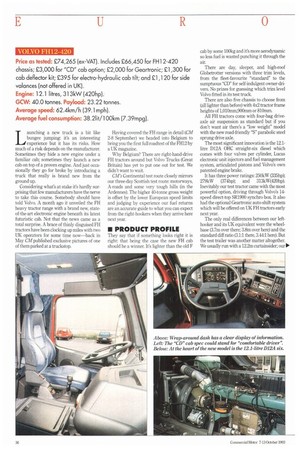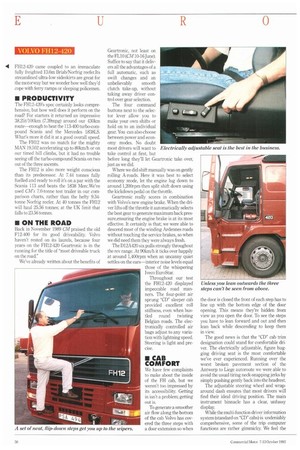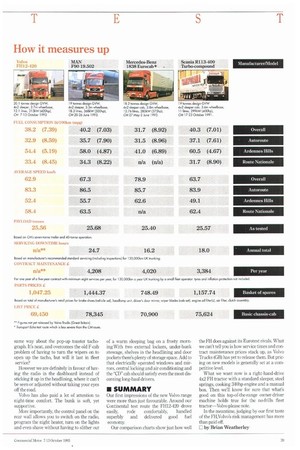L aunching a new truck is a bit like bungee jumping:
Page 38

Page 40

Page 41

If you've noticed an error in this article please click here to report it so we can fix it.
it's an interesting experience but it has its risks. How much of a risk depends on the manufacturer. Sometimes they hide a new engine under a familiar cab; sometimes they launch a new cab on top of a proven engine. And just occasionally they go for broke by introducing a truck that really is brand new from the ground up.
Considering what's at stake it's hardly surprising that few manufacturers have the nerve to take this course. Somebody should have told Volvo. A month ago it unveiled the FH heavy tractor range with a brand new, stateof-the-art electronic engine beneath its latest futuristic cab. Not that the news came as a total surprise. A brace of thinly disguised FH tractors have been clocking up miles with two UK operators for some time now—back in May CM published exclusive pictures of one of them parked at a truckstop. Having covered the FH range in detail (CM 2.8 September) we headed into Belgium to bring you the first full roadtest of the FH12 by a UK magazine.
Why Belgium? There are right-hand-drive FH tractors around but Volvo Trucks (Great Britain) has yet to put one out for test. We didn't want to wait.
CM'S Continental test route closely mirrors our three-day Scottish test route: motorways, A-roads and some very tough hills (in the Ardennes). The higher 40-tonne gross weight is offset by the lower European speed limits and judging by experience our fuel returns are an accurate guide to what you can expect from the right-hookers when they arrive here next year.
• PRODUCT PROFILE
They say that if something looks right it is right: that being the case the new FH cab should be a winner. It's ighter than the old F cab by some 100kg and it's more aerodynamic so less fuel is wasted punching it through the air.
There are day, sleeper, and high-roof Globetrotter versions with three trim levels, from the fleet-favourite "standard" to the sumptuous "CD" for self-indulgent owner-drivers. No prizes for guessing which trim level Volvo fitted in its test truck.
There are also five chassis to choose from (all lighter than before) with 4x2 tractor frame heights of 1,010mm.900mm or 810mni.
All FH tractors come with four-bag driveaxle air suspension as standard but if you don't want air there's a "low weight" model with the new mad-friendly "S" parabolic steel sprung drive axle.
The most significant innovation is the 12.1litre D12A OHC straight-six diesel which comes with four valves per cylinder, Lucas electronic unit injectors and fuel management system, articulated pistons and Volvo's own patented engine brake.
It has three power ratings: 250kW (335hp); 279kW (374hp); and 313kW(420hp). Inevitably our test tractor came with the most powerful option, driving through Volvo's 14speed direct-top SRI900 synchro box. It also had the optional Geartronic auto-shift system which will be offered on UK FH tractors early next year.
The only real differences between our lefthooker and its UK equivalent were the wheelbase (3.7m over there; 3.8m over here) and the standard dill ratio (3.1:1 there, 3.44:1 here). But the test trailer was another matter altogether. We usually run with a 12.2m curtainsider; our!
• FH12-420 came coupled to an immaculate
fully freighted 13.6m Briab/Norfrig reeferas streamlined ultra-low sideskirts are great for the motorway but we wonder how well they'd cope with ferry ramps or sleeping policemen.
• PRODUCTIVITY
The FH12-420's spec certainly looks comprehensive, but how well does it perform on the road? For starters it returned an impressive 38.21it/100km (7.39mpg) around our 430Imi route—enough to beat the 113-400 turbo-compound Scania and the Mercedes 1838LS. What's more it did it at a good overall speed.
The FH12 was no match for the mighty MAN 19.502 accelerating up to 80km/h or on our timed hill climbs, but it had no trouble seeing off the turbo-compound Scania on two out of the three ascents.
The FH12 is also more weight conscious than its predecessor. At 7.44 tonnes fully fuelled and ready to roll it's on a par with the Scania 113 and beats the 1838 Merc.We've used CM's 7.0-tonne test trailer in our comparison charts, rather than the hefty 9.34tonne Norfrig reefer. At 40 tonnes the FH12 will haul 25.56 tonnes; at the UK limit that falls to 23.56 tonnes.
• ON THE ROAD
Back in November 1989 CM praised the old F12-400 for its good driveability. Volvo haven't rested on its laurels, because four years on the FH12-420 Geartronic is in the running for the title of most driveable truck on the road."
We've already written about the benefits of Geartronic, not least on the FL10 (CM10-16 June). Suffice to say that it delivers all the advantages of a full automatic, such as swift changes and an unbelievably smooth clutch take-up, without taking away driver control over gear selection.
The four command buttons next to the selector lever allow you to make your own shifts or hold on to an individual gear. You can also choose between power and economy modes. No doubt most drivers will want to take control at first, but before long they'll let Geartronic take over, just as we did.
Where we did shift manually was on gently rolling A-roads. Here it was best to select economy mode, let the engine lug down to around 1,200rpm then split shift down using the kickdown pedal on the throttle.
Geartronic really scores in combination with Volvo's new engine brake. When the driver lifts off the throttle it automatically selects the best gear to generate maximum back pressure,ensuring the engine brake is at its most effective. It certainly is that; we were able to descend most of the winding Ardennes roads without touching the service brakes, so when we did need them they were always fresh.
The D12A420 six pulls strongly throughout the rev range. At 90km/h it ticks over happily at around 1,400rpm when an uncanny quiet settles on the ears—interior noise levels equal those of the whispering Iveco EuroStar.
Throughout our test the FH12-420 displayed impeccable road manners. The four-point air sprung "CD" sleeper cab provided excellent roll stiffness, even when hustled round twisting Belgian roads. The electronically controlled air bags adjust to any variation with lightning speed. Steering is light and precise.
• CAB COMFORT
We have few complaints to make about the inside of the FR cab, but we weren't too impressed by its accessibility. Getting in isn't a problem; getting out is.
To generate a smoother air flow along the bottom of the cab Volvo has covered the three steps with a door extension so when the door is closed the front of each step has to line up with the bottom edge of the door opening. This means they're hidden from view as you open the door. To see the steps you have to lean forward and out and then lean back while descending to keep them in view.
The good news is that the "CD" cab trim designation could stand for comfortable driver. The electrically adjustable, figure hugging driving seat is the most comfortable we've ever experienced. Running over the worst broken pavement section of the Antwerp to Liege autoroute we were able to avoid the usual tiring neck-snapping jerks by simply pushing gently back into the headrest.
The adjustable steering wheel and wraparound dash ensures that most drivers will find their ideal driving position. The main instrument binnacle has a clear, unfussy display While the multi-function driver information system (standard on "CD" cabs) is undeniably comprehensive, some of the trip computer functions are rather gimmicky. We feel the
same way about the pop-up toaster tachograph. It's neat, and overcomes the old F-cab problem of having to turn the wipers on to open up the tacho, but will it last in fleet service?
However we are definitely in favour of having the radio in the dashboard instead of sticking it up in the headlining, where it can't be seen or adjusted without taking your eyes off the road.
Volvo has also paid a lot of attention to night-time comfort. The bunk is soft, yet supportive.
More importantly, the control panel on the rear wall allows you to switch on the radio, program the night heater, turn on the lights and even shave without having to slither out
of a warm sleeping bag on a frosty morning.With two external lockers, under-bunk stowage, shelves in the headlining and door pockets there's plenty of storage space. Add to that electrically operated windows and mirrors, central locking and air conditioning and the "CD" cab should satisfy even the most discerning long-haul drivers.
RI SUMMARY
Our first impressions of the new Volvo range were more than just favourable. Around our Continental test route the FH12-420 drove easily, rode comfortably, handled superbly and delivered good fuel economy.
Our comparison charts show just how well the FH does against its Eurotest rivals. What we can't tell you is how service times and contract maintenance prices stack up, as Volvo Trucks (GB) has yet to release them. But pricing on new models is generally set at a competitive level.
What we want now is a right-hand-drive 4x2 FH tractor with a standard sleeper, steel springs, cooking 340hp engine and a manual box. Then we'll know for sure that what's good on this top-of-the-range owner-driver machine holds true for the no-frills fleet tractor-Volvo please note.
In the meantime, judging by our first taste of the FH,Volvo's risk management has more than paid off.
I: by Brian Weatherley




























































































